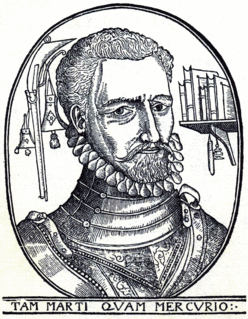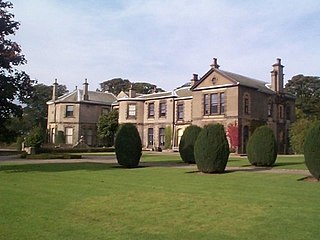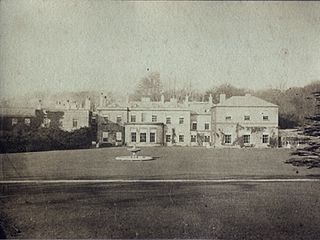
George Gascoigne was an English poet, soldier and unsuccessful courtier. He is considered the most important poet of the early Elizabethan era, following Sir Thomas Wyatt and Henry Howard, Earl of Surrey and leading to the emergence of Philip Sidney. He was the first poet to deify Queen Elizabeth I, in effect establishing her cult as a virgin goddess married to her kingdom and subjects. His most noted works include A Discourse of the Adventures of Master FJ (1573), an account of courtly intrigue and one of the earliest English prose fictions; The Supposes,, an early translation of Ariosto and the first comedy written in English prose, which was used by Shakespeare as a source for The Taming of the Shrew; the frequently anthologised short poem "Gascoignes wodmanship" (1573) and "Certayne Notes of Instruction concerning the making of verse or ryme in English" (1575), the first essay on English versification.

Sir William Gascoigne was Chief Justice of England during the reign of King Henry IV.

William Gascoigne was an English astronomer, mathematician and maker of scientific instruments from Middleton, Leeds who invented the micrometer and the telescopic sight. He was one of a group of astronomers in the north of England who followed the astronomy of Johannes Kepler, which included Jeremiah Horrocks and William Crabtree.

Lotherton Hall is a country house near Aberford, West Yorkshire, England. It lies a short distance from the A1(M) motorway, 200 miles (320 km) equidistant between London and Edinburgh. It is one of nine sites in the Leeds Museums & Galleries group.

Parlington Hall was the seat of the Gascoigne family, Aberford near Leeds in West Yorkshire, England.

The Gascoigne Baronetcy, of Barnbow and Parlington in the County of York, was a title in the Baronetage of Nova Scotia. It was created on 8 June 1635 for John Gascoigne. He had converted to Roman Catholicism in 1604. His son Sir Thomas, 2nd Baronet, was accused of conspiracy to murder King Charles II as part of the mythical Popish Plot, but acquitted. The eighth Baronet was Member of Parliament for Thirsk, Malton and Arundel. He renounced Catholicism, and was much involved in the Irish Parliament and in horse racing. Sir Thomas died in 1810, the year after his only son died in a hunting accident, upon which the baronetcy became either extinct or dormant.
Gascoigne is a British surname of Old French origin, the regional name of Gascony. The surname first appears on record in England in the early 13th century. Gascoigne or Gascoine may refer to:

Thomas Watson-Wentworth, 1st Marquess of Rockingham, KB, PC (I) of Wentworth Woodhouse, Yorkshire was a British Whig politician who sat in the House of Commons from 1715 until 1728 when he was raised to the Peerage as Baron Malton.

Sir Thomas Gascoigne, 8th Baronet was born on 7 March 1745 on the Continent into a devout Catholic gentry family based in Yorkshire. Despite receiving a solid Catholic education at institutions in northern France and Italy, Gascoigne would later renounce his religion to become a Foxite Whig Member of Parliament. Prior to his apostasy he travelled extensively as a Grand Tourist throughout much of Spain, France and Italy in the company of the noted travel writer Henry Swinburne, who would later record their journeys in two popular travel guides Travels through Spain in the Years 1775 and 1776 (1779) and Travels in the Two Sicilies, 1777–1780 (1783–5). Together they gained close access to the leading courts of Europe, particularly in Spain and Naples. An honorary member of the Board of Agriculture, Gascoigne was an important advocate of agricultural reform as well as a considerable coal owner who helped pioneer technological developments in the extractive industries. He is emblematic of how movements within the Enlightenment were having a major influence on the attitudes, activities and outlook of many leading English Catholic gentry families in the period.

Sir Thomas Gascoigne, 2nd Baronet (1596–1686) was an English Baronet, a prominent member of the Gascoigne family and a survivor of the Popish Plot, or as it was locally known "the Barnbow Plot".

All Saints' Church is a 15th-century redundant church in the park of Harewood House, the seat of the Lascelles Earls of Harewood, near the village of Harewood, West Yorkshire, England. It is recorded in the National Heritage List for England as a designated Grade I listed building, and is under the care of the Churches Conservation Trust. The church stands in isolation within Harewood Park, as the surrounding village was relocated by the owner of Harewood House, in about 1760, to a location further from the house. Inside the church is the family vault of the Earls of Harewood and a set of six alabaster monuments, which are "the largest collection of alabaster monuments in a parish church within the dates 1419–1510".
Sir Charles Turner, 1st Baronet was a British politician and Lord Mayor of York.
Sir Thomas Fairfax was an owner of Gilling Castle, near Gilling East, North Riding of Yorkshire, England.
Sir Christopher Wyvill, 3rd Baronet was an English politician who sat in the House of Commons in 1659 and 1660.
John Gascoigne may refer to:
Sir John Neville, of Chevet in Yorkshire, was an English landowner, courtier, soldier, administrator and politician who was executed for treason under King Henry VIII.
Sir Thomas Hilton was an English politician.
Sir Richard Tempest was an English landowner, courtier, soldier, administrator and legislator under Kings Henry VII and Henry VIII who was imprisoned after joining the Pilgrimage of Grace and died in jail.
Laura Gwendolen Douglas Galton Gascoigne was a British nurse, writer, and singer. She was appointed Commander Order of the British Empire (CBE) in 1918. She was appointed Dame of Justice, most Venerable Order of the Hospital of St. Johns of Jerusalem.
Richard Gascoigne was an English antiquarian.








